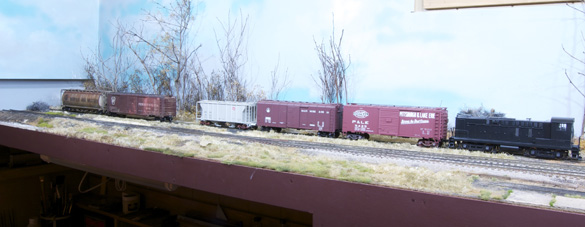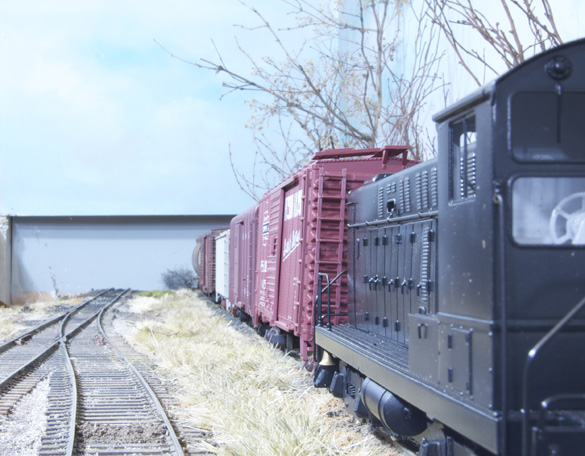“It’s a little bizarre to back up a 3000 foot train without any visual reference, or to operate long hood forward and not see anything on your opposite side for hundreds of feet! The trainmen on the ground are your eyes. You learn to rely on what they are seeing and communicating back to you.”
Greg Amer, Railroad professional.
To put that distance into perspective, if you routinely haul a trailer of some kind, imagine trying to tie on to it with a hitch as long as ten football fields, or trying to see what’s happening from over a half mile away. Hmmm.
Where are you?
In your imagination, where are you when you’re running/operating a train on your layout? Are you the brakeman/conductor hanging off the lead car in a reverse move, or are you supposedly in the locomotive cab manning the throttle and brakes? Or, are you in the helicopter hovering a couple of hundred or more feet above it all? What helicopter you ask? The one represented by your viewpoint at standing eye level. The one that allows you to see the entire train and track situation in one sweep of the eyes over a scene.

The typical helicopter view from my standing eye level. From this vantage point, it’s easy to tell how much farther to shove before making the hook. Note* I had the camera back from the edge of the layout more than I normally would to shoot this photo. You get the idea though.
Greg’s quote has stayed with me ever since I read it. It’s part of an interview on switching operations he gave me for an upcoming volume of The Missing Conversation, due out this summer. As a locomotive engineer in the cab, his sight lines are restricted in ways we can’t begin to imagine. Why is this so hard for us? The aforementioned helicopter viewpoint.

Where is your ground man? How much farther do I have to go before coupling on? From the scale engine crew’s perspective, it’s impossible to tell. What if we had to operate from this viewpoint instead of the one in the first photo?
Even on a quarter-inch scale layout, our viewpoint from standing eye level can be anywhere, from eleven inches in my case, to a couple of feet, if the layout is built low to the floor. That’s anywhere from forty-four to one hundred scale feet above the ground. In real world terms, that’s like looking down from a four to ten story high window watching a train do its thing. Most of us operate accordingly, by taking in everything at once. We know in advance where to stop, how far to shove a cut in reverse, which way the switchpoints are set from ten car lengths away and so on. As modelers we’ve be doing this without thought for decades. Call it a legacy from the train set era of tabletop layouts, or whatever you wish, it has greatly influenced our views of operations.
If you operate solo as I prefer to do, you’re likely in the conductor/brakeman mindset more than engineer. Much of my mental process goes toward figuring out moves and sorting out cars. I run the train by instinct, flipping the reversing switch and twisting the throttle knob to make the train do what I want without giving it a lot of thought. I suspect you do the same.
If you have a two person crew, then the two jobs are divided between you and a friend. He does the thinking while you do the grunt work. Or vice versa. My hunch is that whoever is running the locomotive, are making the moves without waiting for instruction because he can also see the whole picture as it happens. So he or you, are already a step or two ahead of the game in terms of what has to happen next.
Take another look at the second photo and read Greg’s quote again, then put yourself in his position in the cab. Different feeling all together isn’t it.
With this post, I’m not telling anyone how to play with their trains. It’s your hobby, run them as you please. I’m simply sharing something I’ve seldom considered but just learned. This stuff may sound like a bunch of hooey or even worse, work. Maybe, it’s also a way to add increased value to your operations by providing a greater understanding of what the real world operations actually involve. Take what you want from it.
There’s much more coming in the full interview with Greg later this year.
Regards,
Mike
Mike, an operational option with a two+ person team would be to have the engineer to stand some distance down the line–not feet away from the layout, just down the line to linearize the engineer’s view and force a need to follow hand signals of the crew.
It won’t achieve the full effect of forcing a cab perspective, but would eliminate a need to raise a layout to eye level.
Welcome Rick,
Good idea. We’ll never get to fully appreciate the restricted view of a full size engineer with our models. Our normal helicopter viewpoint simply highlights the vast difference in perception between the full size world of railroading and our vastly smaller models
I know your name was included but as a courtesy to all, I ask that folks sign their comments.
Regards,
Mike
Mike,
One of my friends has an interesting variation on this theme. He has a full size operational diesel locomotive control stand in the middle of his railroad. The control stand has been modified internally to provide power to the track as a realistic reflection of the position of the throttle, brake, and direction handles. In other words using the stand gives a real feel for the locomotive’s actual response. If you don’t move the handles correctly and in the proper sequence, nothing happens. He happens to be a real life engineer, so qualified training is available on the spot for anyone who wants to try out the system, but is unfamiliar with the actions required.
His railroad is also a switching type. Therefore if switching any distance from the stand, 2-way radios and a ‘man on the ground’ is required. This is truly a unique experience and quite different from the norm.
For those times when the railroad is run solo, an alternate throttle system allows one to walk around with the train.
Regards, Ben Brown
Hi Ben,
Remember the scaled down steam loco controls that Jack Burgess built in the ’70s? Similar concept and interesting to boot. Way beyond my feeble skill and understanding though.
Regards,
Mike